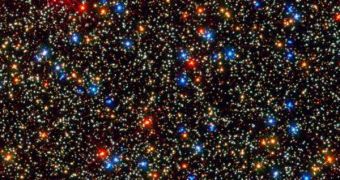While surveying the night sky, a team of astronomers was able to image a narrow portion of a massive globular star cluster, which lies some 16,000 light-years away from Earth, in Omega Centauri. It is estimated that the stars in this structure are between 10 and 12 billion years old.
An estimated 10 million stars can be seen in this cluster. Such structures are ancient swarms of celestial fireballs, which appeared at the end of the reionization epoch, a billion years or so after the Big Bang.
Analyzing the recently-discovered cluster, called JKCS041, is very important because it may hold clues as to how and why the Universe evolved to take on its current shapes and sizes.
The object may also help explain how galaxies assembled and when. The stars that made it up appeared just around the same time when astrophysicists hypothesize that galaxy clusters may have appeared.
No one knows for sure when these structures first entered the scene, but scientists did conduct some investigations in which they simply extrapolated the time it would take for millions of stars to form, come together, and make galaxies, which would then flow together to form clusters.
Astronomers discovered the most distant such structure a short while back. Located some 10.2 billion light-years away, this cluster is the oldest known to date, preceding the next one in the top by 1 billion years.
It was discovered by combining data collected by the NASA Hubble Space Telescope with results of observations conducted with the Chandra X-ray Observatory. Additional bits of data were collected by several infrared telescopes.
“This object is close to the distance limit expected for a galaxy cluster. We don't think gravity can work fast enough to make galaxy clusters much earlier,” says expert Stefano Andreon.
The astronomer holds an appointment at the National Institute for Astrophysics (INAF), in Milan, Italy.
There is currently a large number of questions that experts want to answer by studying the near-by star clusters. One of the mysteries that could be solved is that surrounding the mechanism through which chemical elements are formed in such objects.
Astronomers also want to learn whether the globular cluster is still developing, after all these billions of years. All of these questions, and more, are bound to find an answer soon, Daily Galaxy reports.

 14 DAY TRIAL //
14 DAY TRIAL //